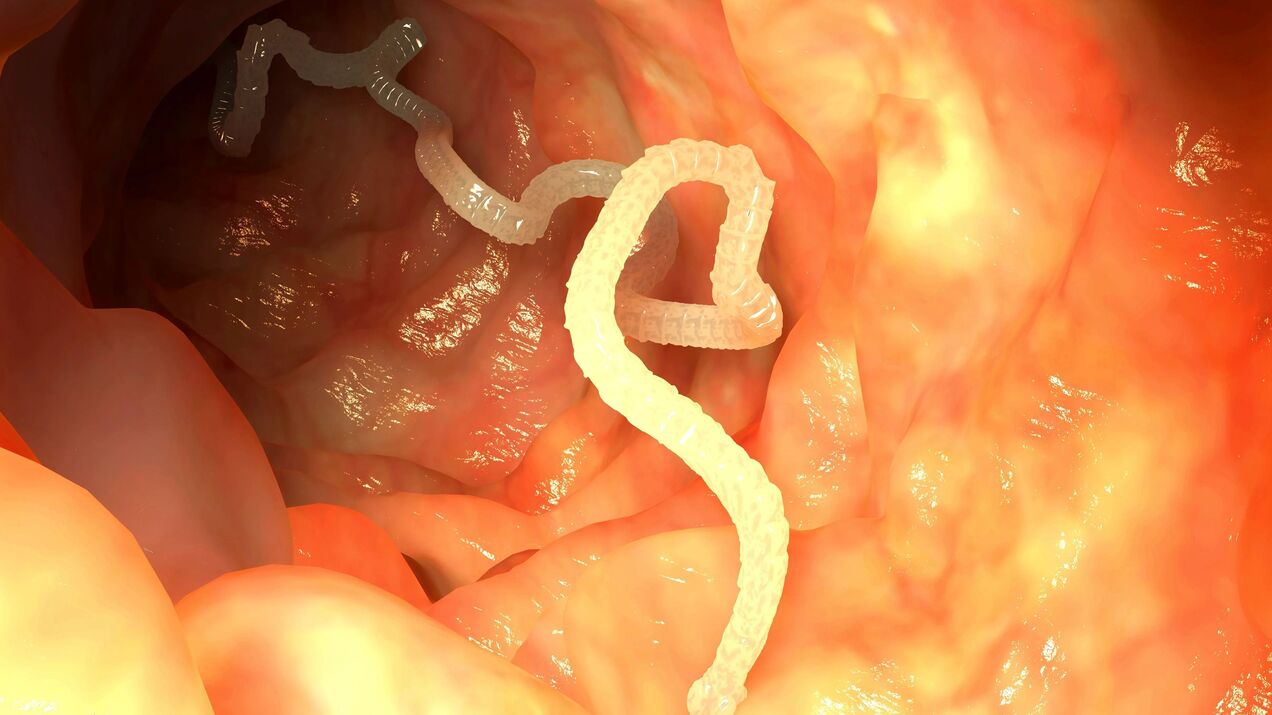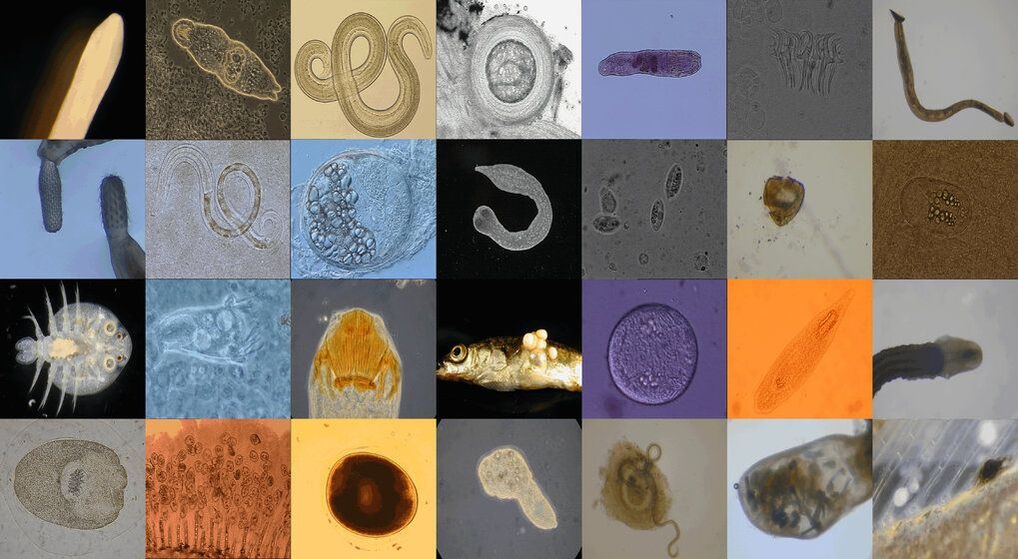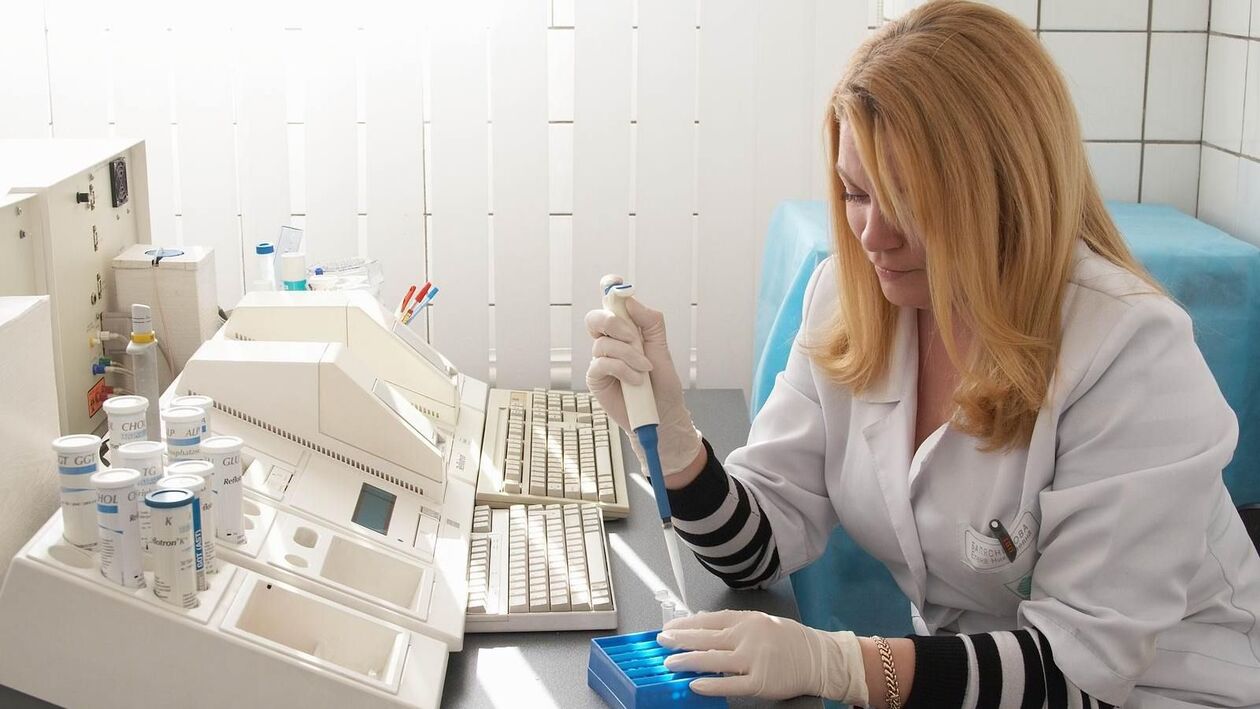
Worm infections often cause discomfort and significant health problems for a person. Symptoms of worms can be very diverse: fever, weakness, abdominal pain, headache, etc. v.
Worms - what are they?

As we said above, adult worms traditionally have a stable location in the body and their developmental forms often migrate to different organs and tissues and often their migration paths are quite complex. . For example, with ascariasis, a person becomes infected by eating food contaminated with ringworm eggs (roundworm eggs that ripen in the ground).
In the intestinal cavity, roundworm eggs hatch into larvae, which within a few hours penetrate the intestinal wall into the blood vessels and are carried into the lungs through the bloodstream. In the lungs, roundworm larvae develop and mature. The developing larva slowly gnaws into the neighboring bronchi and crawls along them, first into the trachea, then into the oral cavity, where it is again swallowed and introduced into the intestinal tract.
Roundworm larvae that return to the intestinal tract will transform into adult worms. Migration into the lungs of nematode larvae is manifested by a variety of symptoms (coughing, asthma attacks, increased body temperature, allergic skin rashes) and the presence of small numbers of adult worms. intestinal wall may not manifest in any way.
What is helminth disease (helminthiasis) - Symptoms of worms

The term helminth most often means a number of human diseases, the antecedents of which are various types of parasitic worms - helminths (another common name for these parasites - worms).
Unlike diseases caused by bacteria, protozoa or fungi, with helminths, the number of adult helminths in the body of an infected person does not increase at any one time (except in cases of reinfection). This is because heartworms reproduce outside the human body.
Who are they?
Medicine knows more than a hundred types of helminths. The following are the most common types of worms:
- Pinworms are small worms in the human body that are 12 mm in length. This type of worm is diagnosed in the intestinal mucosa. Parasites enter the body through respiratory dust and can be easily transmitted from person to person.
- Roundworms are large roundworms most commonly found in the small intestine. Infection of the body occurs through unwashed hands and food. Most often, roundworms are found in children's bodies.
- Trichinella - these parasites have round bodies no more than 5 mm long and cause trichinosis in the body. Larvae and eggs like to be in lightly fried meat (wild boar, pig, bear). In the human body, Trichinella takes up to 4 days to mature and its life cycle is 40 days. The main goal of this worm is to enter the bloodstream through the intestinal wall and settle in the muscles. Furthermore, the muscles of the respiratory and musculoskeletal systems are often affected.
- Pork/beef tapeworm. The body length of the parasite is 5-6 meters, and its larvae hide in the meat of large animals (pork, cattle). The disease caused by these helminths is called taenosis and taeniarinhoz. The larvae of both tapeworms are white blisters attached to the wall of the small intestine. It takes the parasite 3 months to develop and form adults, and the worms develop every day. The total number of segments is up to 2000, the last segment is free to "groove" the large intestine. The worms then leave the body along with feces through the anus. The most common and obvious symptoms of helminthiasis are disruption of the digestive tract, as well as eating in large quantities and the patient not gaining weight.
- Necator/hookworm. The connection between these parasites is direct due to the diseases and biology they cause. They live in the duodenum and, due to their small size (10-15 mm), they move freely in its environment. The larvae can only enter the body through the skin if the person comes into contact with contaminated soil. The next target of the worm is the lungs along with the digestive tract. They only eat blood flowing from bitten blood vessels. Due to the intense activity of these parasites, blood clotting is disrupted. Adults consume blood in the range of 0. 1-0. 35 ml per day.
- Echinococcus. In this case, a person acts as an intermediate host, since the final hosts are wolves, cats and dogs. Animals can become infected through direct contact with contaminated objects or people. As soon as the parasite's eggs enter the intestine, larvae with six hooks will immediately develop, which in medicine are called oncospheres.
- Whipworm is diagnosed in a person's stomach. These are thin and quite large worms.
You can identify the type of worms by looking at the color of the worms in the stool when they appear. Infection occurs through inadequately heat-treated vegetables and meat. You can avoid infection by following the rules of food preparation.
How common and dangerous are worms?
Symptoms of worms. Data from modern epidemiological studies have revealed that every fourth person worldwide is infected with worms. The rate of worm infection in children is significantly higher than in adults. In children and adults, worms can become a prerequisite for various acquired diseases of internal organs (gastritis, pancreatitis, enteritis, cholecystitis), and sometimes lead tothe development of unsafe complications and death.
According to the Global Health Organization and the Global Bank for Diseases, helminthiasis ranks fourth in economic harm among all other diseases and injuries.
In our area, there are more than 15 types of worms, the most common of which are helminthiasis (about 90% in the group of patients with helminthiasis), ascariasis (70%), opisthorchiasis, diphtheria, trichocephalopathy (60%), toxocariasis (60%) and hymenospermia. According to statistics, almost all sick people (especially children) are simultaneously infected with many forms of worms.
Where do worms spread in humans?
Many people believe that worms definitely live in the intestines, and for some types of helminths this is true. In general, worms can be found in many different organs and systems of the human body:
- All types of tapeworms, whipworms and nematodes "settle" in the large intestine;
- Trematodes attack the liver and gallbladder;
- Pork tapeworm larvae can spread through the bloodstream to all organs - fatty tissue under the skin, eye chambers and blood vessels in the muscles can be affected.
How can you get worms?
How do worms enter the human body? There are 4 main sources of helminth eggs entering the body:
Cysticercosis- through soil (and later water), in which mature eggs of many types of helminths enter the ground with human or animal feces, as well as through direct contact with animals and through transmission by flieseggs to food. to humans The most famous and common worms such as pinworms are transmitted; This is the highest risk of infection.
Biological helminths- when eating raw, semi-raw or lightly heat-treated meat (pork, beef) or fish infected with helminths (sushi, kebab, dried fish, lard with streaks of meat, etc. ) Some invasive parasitesEnters the body through insect bites
The main mechanism of any infection is usually the fecal-oral route, meaning that a person simply swallows helminth eggs with food, water and, less commonly, some helminth infections occur from wounds. bites from infected insects. Undercooked meat and raw fish are understandable, but how can you get worms through contact, household contact and through soil?
Through land
After contact with soil or sand, you should not only wash your hands but also clean your nails thoroughly and cut them short, especially for children. Food products that grow above ground - vegetables, herbs, fruits, berries, mushrooms, everything that comes into contact with the ground need to be thoroughly washed under running water and scalded with boiling water. Pets, mainly dogs and cats, walking on the street bring a lot of sewage into the house and children playing with them are at the highest risk of infection, animals can easily transmit any type of helminth. Flies are also the main vectors of helminths. In public toilets, where agricultural livestock live, flies then calmly land on food, laying eggs on the wings and feet.
From one person to another
With pinworms, infection to others is very easy. When the female pinworm crawls out of the intestines at night, it lays about 5, 000 eggs near the anus, causing intense itching. Children who scratch the itchy area will infect their hands, nails, underwear, and bed sheets. If you don't wash your hands immediately, hundreds of eggs will deposit on every object your child touches - doorknobs, clothes, food, toys. Moreover, the infection process is obvious, eggs also fall into the hands of a child or other adult when using these items, and if hands are not washed before eating, they will fall into the mouth of a healthy person.
Through water
Large numbers of worm eggs live in open water bodies and well water. Therefore, people living in the countryside or in the countryside should use antibacterial filters and remember to boil water, swallowing water when swimming in open water is also dangerous.
Everyone knows that worms are mainly a problem for children. Firstly, because they are most susceptible to developing helminth infections, because the protective barrier in children's bodies has not been properly formed and the acidity of the stomach is lower than in adults. Second, children of preschool age, mastering the world, try all the surrounding objects not only with their hands, but also with their taste buds. And parents, with all their wishes, can teach their child to strictly adhere to the rules of personal hygiene without reminders, only at the age of 3-6, which not only makes the baby himselfbut also family members are in danger. infection (pinworm).
It should be remembered that no type of worm can reproduce and multiply in the human body, each species has its own period of time after which they die, for example, for pinworms it is only a few weeks, for roundworms it is only a few weeks. about a year. The eggs laid by the adult must leave the body in the feces or (in the case of pinworms) on the skin near the anus, into the external environment, into the soil and only then, mature outside the human bodyand invade again, they begin to become active and parasitic.
Symptoms of worms

The development of helminthiasis usually occurs in two stages: acute - from two or three weeks to two months and chronic - from several months to many years.
The acute phase coincides with parasite invasion and development and is manifested mainly by immune responses to foreign antigens and allergic reactions. The symptoms of this stage of helminth disease are similar as many different types of parasites appear.
The chronic stage is distinguished by great diversity: depending on the location of the worms, their quantity and lifestyle, disorders appear in the functioning of various organs and systems. By integrating into the metabolic system, consuming substances necessary for itself, the parasite leads to disorders, manifested by disorders of digestion and absorption of vitamins, proteins, fats, carbohydrates and minerals. Worm waste not only inhibits normal intestinal microflora, but also reduces immunity, promotes the development of chronic bacterial infections, and reduces the effectiveness of preventive vaccinations.
The increased risk of malignant tumors is associated with a negative effect on the immune system and enhanced cell division (regeneration) in damaged tissues.
The first signs of the development of helminthiasis can appear from 2-3 days (with ascariasis) to 1. 5 years (with filariasis). Usually this period is 2-3 weeks. At the beginning of the disease, skin rashes, swollen lymph nodes, enlarged liver and spleen, muscle and joint pain appear. Some helminths are characterized by specific signs, such as jaundice due to opisthorchiasis (liver flukes) or fever, muscle pain, and swelling of the face and eyelids due to trichinosis.
In the chronic phase, the presence of single specimens of worms practically does not cause any symptoms, except that there may be the presence of large specimens, for example, tapeworms and roundworms. In cases where the infection is more widespread, symptoms of helminth infection include digestive disorders (nausea, bloating, abdominal pain, loose stools) and some specific signs. For example, with intestinal worms, itching in the anus increases in the evening and at night.
With trichocephalus, it is hemorrhagic colitis (with bleeding). With hookworm - iron deficiency anemia. With ascariasis, mechanical obstruction of the intestines and bile ducts may occur. With helminthiasis, liver damage, chronic hepatitis and cholangitis (cholecystitis, cholangitis) develop.
A special place is occupied by helminths with the development of cysts (fluid formation in the membrane): echinococcosis, alveococcosis, hydatid disease. Even large cysts may not manifest themselves in any way, but their suppuration or rupture will lead to serious consequences such as: anaphylactic shock, peritonitis, purulent pleurisy. Helminthiasis may be accompanied by symptoms of vegetative-vascular weakness and neurological conditions. Let's consider in more detail the most common special cases of helminthiasis.
Diagnosis of worms. Worm treatment

With intestinal helminths, the main conditions for successful treatment are simultaneous deworming of all family members (or groups of children), strict hygiene measures and repeated medication after 10-14 days from the first time.
Folk remedies to treat worms
Traditional treatments include medicinal plants that have anthelmintic and laxative effects. Even in ancient times, healers recommended elecampane and celandine juice to expel worms. Carrots and carrot juice also have anthelmintic effects. Often in traditional medicine recipes you can find walnuts, pomegranates, mint, and even more often - garlic in the form of nutritional ingredients or enemas. A decoction of wormwood is used as an enema or taken orally. Pumpkin seeds are a medicine officially recognized as a remedy for worms. In folk medicine, the use of medicinal plants is often combined with saline laxatives. Although the effectiveness of medicinal plants is not high, they can be used as a preventive method or supplement to traditional helminth treatments.
Complications of helminth disease
Complications of helminthiasis are mainly related to the mechanical impact of the parasite on the organs; Tissue destruction sometimes leads to fatal dysfunction of the affected organ. Additional bacterial infection in places of mechanical damage is a common complication that masks the presence of parasites in the body. For susceptible people, the sight of parasites (for example, when expelled) can cause severe psychological trauma, requiring long-term rehabilitation treatment.
Worm prevention
Includes timely identification and treatment of sick people and animals, compliance with personal hygiene measures (washing hands before eating, thoroughly washing food, thoroughly heat treating food, especially meatand fish).
Frequently asked questions
What symptoms can indicate the presence of worms in a person?
Symptoms of worms can include constant fatigue, loss of appetite, weight loss, abdominal pain, itching in the anal area, and digestive problems such as diarrhea or constipation.
How can you determine if a person has worms?
To determine the presence of worms in your body, you can perform a stool test to look for worm eggs or do a blood test to look for the presence of anti-worm antibodies. Your doctor may also prescribe an ultrasound or other diagnostic procedures to confirm the diagnosis.
What precautions can be taken to prevent worm infections?
To prevent worm infections, you should regularly wash your hands with soap and water, especially before eating and after using the toilet. You should also avoid contact with contaminated soil or water, drink only clean drinking water, and cook food properly to destroy any worm eggs that may be present.
Helpful advice
Tip #1
Pay attention to changes in appetite and weight. If you or your child feels constantly hungry or, conversely, has a loss of appetite, this may be a sign of helminth infection.
Tip number 2
Pay attention to the condition of your skin and hair. If you or your child has a rash, itching, or changes in hair texture (such as brittleness or hair loss), it may be due to the presence of worms.
Tip number 3
Pay attention to the activity of the digestive tract. If you or your child frequently have stomach aches, constipation or diarrhea, it may be due to a worm infection.





























